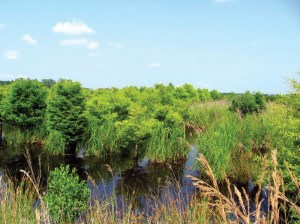Amy-Lynn Albertson: Salisbury’s wetlands
Published 12:00 am Saturday, January 28, 2023

- Some water lilies can help filter nitrates out of the water.
By Amy-Lynn Albertson
N.C. Cooperative Extension
Have you ever noticed the swampy land on Jake Alexander Boulevard? If so, have you wondered why it’s there? That is a wetland, and it’s an essential natural resource, making up a significant amount of the landscape in North Carolina. In the not-too-distant past, wetlands were considered obstacles to the wellbeing of our citizens. Estimates are that over 50% of the wetlands here when colonists first settled our state are now gone. Many were drained and filled for agriculture, development and mosquito control. Some were damaged inadvertently from nearby activities that resulted their being filled in by sediment. Still others were decimated by pollution. Some people continue to have unfavorable perceptions about wetlands. However, over the last few decades, scientists and engineers have shown that natural wetlands provide not only a unique plant and animal habitat, but also numerous benefits to society and our economy, including flood control, water quality protection and carbon storage. Because of their many recognized benefits, wetlands are now a protected natural resource. When activities such as development, road construction and agriculture or forestry operations negatively impact or destroy them, they must be rebuilt through a process known as wetland restoration.
Natural wetlands have been studied for their ability to capture and transform many pollutants. In the right situation, wetlands can intercept surface and groundwater and slowly release it over time. This interception allows particles of soil or debris to settle out and accumulate, releasing visibly cleaner water. They can also trap sediment-bound pollutants, like excess metals and phosphorous. Vegetation often grows readily and accumulates over time in wetlands, creating an environment high in organic matter and microbial activity. Nitrate, a common form of nitrogen fertilizer usually found in runoff, can pollute rivers and lakes. When intercepted by wetlands, however, nitrate can be used instead of oxygen by certain microorganisms to survive during times of flooding. As water passes through wetlands, the nitrate is transformed by the microbes into nitrogen gas that escapes into the atmosphere in a process called denitrification. The water then leaving the wetland is thereby less polluted.
We can now take advantage of the unique abilities of natural wetlands by constructing them in strategic locations to intercept and treat polluted water. Stormwater runoff from developed urban areas can deliver significant amounts of water, often flowing at high velocity, directly to local streams or other water bodies. Constructed wetlands have been used over the last two decades to slow and store some of that water, much like natural wetlands. Those used in urban areas are known as stormwater wetlands and are one of several measures used by municipalities to reduce the effect of runoff. Stormwater wetlands slow this runoff, store sediment and debris, trap phosphorous and metals, and reduce the amount of nitrogen transported downstream.
Efforts continue to replace wetlands lost to development through restoration and creation. Stormwater and treatment wetlands are also being designed and constructed to use their natural ability to reduce many pollutants in water. Scientists and engineers continue to study methods to effectively build thriving wetlands so that these resources can better benefit society. Wetlands need to be understood and addressed by many of the people they serve. If you are interested in learning more about them, particularly those around Salisbury, Michael Hanna from the Salisbury Public Works Department will be speaking at the Rowan County Extension Center on Tuesday, Feb. 14, at 1 p.m. about Salisbury’s wetlands. This event is free and open to the public. Space is limited and registration is required. Sign up by going to go.ncsu.edu/salisburywetlands or call 704-216-8970.
Amy-Lynn Albertson is director of the Rowan County Extension.





